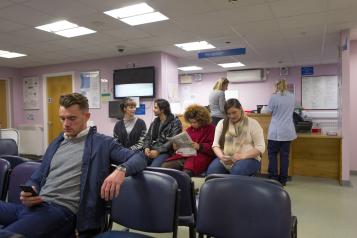How can services learn from people’s experience of A&E?

8,500 people’s views has shown that quality of care, clear communication, and a supportive environment are valued as more important than being seen within a four-hour target.
While the four-hour target helps to illustrate performance across the NHS and can help identify problems, it doesn’t help us understand people’s overall experiences of visiting A&E. This makes it difficult for NHS staff to focus on what matters most to patients when receiving care.
NHS England has announced plans to test a new set of performance measures in 14 hospitals across the country. This includes testing a rapid early assessment for everybody using A&E services to help prioritise more urgent cases, and a one-hour target for people who need emergency care during a mental health crisis.
By testing the proposed measures, NHS England can ensure that they work for both staff and the public, and ultimately have a positive impact on people’s overall experience of emergency care.
How can services improve people’s experiences of A&E?
Early assessments
People who are assessed when they arrive at A&E, often have more positive experiences of emergency care than those who aren’t. By triaging people quickly, services can put patients at ease by outlining the next steps staff will take to care for them. It also means that people who would be better treated elsewhere, can be directed to a more appropriate service, such as a walk in centre.
Consistent communication
Clear and consistent communication is key to improving people’s experiences. People using emergency care services are often not told how long they might have to wait for treatment. To help prevent patient’s from feeling frustrated or confused, it is important that staff communicate how long people can expect to wait, even if this is longer than the four-hour target.
“I got the cotton ball from a cotton bud stuck in my ear. I went to the GP but they couldn’t help me. I was sent to A&E. I got there at 5.30pm and I was seen at 9.30pm. It took 5 minutes to sort the problem out. You have no idea where you are in the queue, they just come and shout for you. There are no ticket numbers as was before. There is no display for the queue. The waiting time stated at 56 minutes.”
It is also helpful when staff update patients if their waiting time is likely to change due to other circumstances. People are usually understanding if A&E departments must prioritise some patients ahead of others, if they are kept informed of any changes.
Supportive environment
A&E departments are often busy and can be overwhelming for people who are already distressed or in pain. Creating a safe and comfortable waiting environment, is therefore crucial in supporting people’s wellbeing and consequently improving their overall experience of accessing emergency care. This is particularly important for people who are waiting with children.
High quality care
People have told us that high quality care is more important than being seen quickly. When treating patients, if services can deliver strong clinical outcomes, in a safe environment, and while treating people with empathy and respect, patients are more likely to feel they have received a good service from emergency care.
National Reports Library
What are people telling Healthwatch about their experiences of A&E?
You can now search and find over 1000 Healthwatch publications about health and care services, by using our National Reports Library.
How will we make sure people's voices are heard?
We've been working with NHS England to ensure that the voices of people who use services are taken into account when evaluating the proposed new standards on people’s experiences of A&E.
To support this, NHS England will work with several local Healthwatch across England to understand the effect of the proposed new standards on people’s experiences of A&E. These local Healthwatch will visit services who are piloting the new standards to speak to patients and their relatives about their views.
This evidence, along with other data about people’s experiences of care, will help to make sure that the new standards take into account the needs of those who use services.
If you have experiences of A&E that you would like to share, contact your local Healthwatch.


